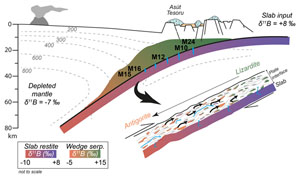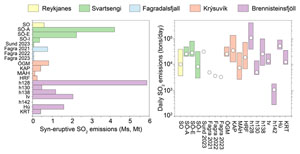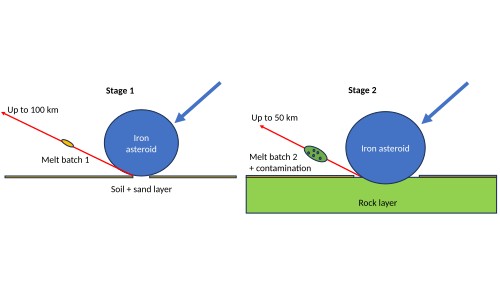 | Direct precipitation of siderite in ferruginous environments Abstract: Siderite (FeCO3) is often assumed to precipitate from dissimilatory reduction of Fe-(oxyhydr)oxides, but geochemical and mineralogical analyses from ferruginous (anoxic, Fe-rich) Canyon Lake, USA, suggest Fe-carbonate represents a direct early precipitate unrelated to substantial oxide burial. X-ray absorption near edge structure (XANES) spectroscopy of sediment trap materials and an anoxic sediment core indicated a mixture of Fe(II) and Fe(III) in water column particulates and ferruginous surface sediments, while all Mn phases were reduced. About 60 cm below the sediment–water interface, Fe-Mn carbonates were detected by X-ray diffraction and XANES, while Fe extended X-ray absorption fine structure (EXAFS) spectra were best fit with combinations of a biogenic Fe-oxyhydroxide (“Bio Fe”), greigite, and siderite. Sediment Fe speciation indicates a large pool of reduced Fe with a minor component of oxides. Although we found no evidence of significant carbonate phases above or below the 60 cm horizon, equilibrium modelling indicates siderite supersaturation throughout surface sediment porewater, with pH as the primary control on supersaturation. We conclude that delivery of wildfire ash to sediments increased pH, initiating siderite precipitation from ferruginous porewater. |
 | Direct evidence of CO2 drawdown through enhanced weathering in soils Abstract: The ability of engineered enhanced weathering to impact atmospheric CO2 has been challenging to demonstrate due to the many processes occurring in soils and the short time span of current projects. Here we report the carbon balance in an Icelandic Histic/Gleyic Andosol that has received large quantities of basaltic dust over 3300 years, providing opportunity to quantify the rates and long term consequences of enhanced weathering. The added basaltic dust has dissolved continuously since its deposition. The alkalinity of the soil waters is more than 10 times higher than in equivalent basalt dust-free soils. After accounting for oxidation and degassing when the soil waters are exposed to the atmosphere, the annual CO2 drawdown due to alkalinity generation is 0.17 t C ha−1 yr−1. This study validates the ability of fine grained mafic mineral addition to soils to attenuate increasing atmospheric CO2 by alkalinity export. Induced changes in soil organic carbon storage, however, likely dominate the net CO2 drawdown of enhanced weathering efforts. |
 | Variable δ11B signatures reflect dynamic evolution of the Mariana serpentinite forearc Abstract: This study aims to uncover the evolving dynamics of element mobility in serpentinised ultramafic clasts within the Asùt Tesoru mud volcano in the Mariana forearc. By employing in situ analysis of trace elements and boron isotopes (δ11B), our findings document a progressive 11B depletion from lizardite- to antigorite-bearing serpentinites, accompanied by a reduction in the incompatible element inventory in some samples. This pattern aligns with either a chemical evolution linked to phase transitions along the slab interface of shallow forearc serpentinites dragged down to depth, or interaction with shallow vs. deep slab fluids. Our results support a scenario of complex fluid and mechanical mixing along the plate interface in the Mariana subduction system, with major implications for the B recycling in convergent margins. |
 | Medieval and recent SO2 budgets in the Reykjanes Peninsula: implication for future hazard Abstract: Exposure to volcanic SO2 can have adverse effects on human health, with severe respiratory disorders documented on short- and long-term timescales. Here, we use melt inclusion and groundmass glass data to calculate potential syneruptive SO2 emissions during medieval and recent (2021–2024) eruptions across the Reykjanes Peninsula, the most populated area of Iceland, which has recently undergone magmatic reactivation with the 2021–2024 eruptions at Fagradalsfjall and Svartsengi. We target 16 individual eruptions from the medieval volcanic cycle at the Reykjanes Peninsula, the 800–1240 AD Fires, along with the 2021–2023 Fagradalsfjall eruptions and the 2023–2024 eruptions at Sundhnúksgígar. We calculate potential SO2 emissions across the RP for the individual eruptions to be in the range of 0.004–6.3 Mt. These estimates correspond to mean daily SO2 emissions in the range of 1000–111,000 t/day, higher than the mean SO2 measurements of 5240 ± 2700 t/day during the 2021 Fagradalsfjall eruption. By using pre-eruptive sulfur values preserved in undegassed melt inclusions, we develop an empirical approach to calculate best- and worst-case potential SO2 emission scenarios of any past or ongoing Reykjanes Peninsula eruption of known effusion rate. We conclude that the potential sulfur emissions across the RP can be significantly higher than observed during the 2021 Fagradalsfjall eruption, mainly because of the more evolved nature and higher sulfur contents of magmas erupted during the medieval period. Based on dominant NW wind directions on the Reykjanes Peninsula, eruptions in Brennisteinsfjöll pose the greatest health hazard to the capital area. Sulfate aerosol produced during long-term eruptions may impact visibility and air quality in the Keflavík Airport area. Our findings enable assessment of SO2 emission scenarios of future eruptions across the RP and can be used together with gas dispersal models to forecast SO2 pollution at ground level, and its impact on human health. |
 | A two stage impact melting process in an impact glass strewn field from the Atacama Desert Abstract: A new type of silica-rich glass has been discovered associated with the known impact glass strewn field of the Atacama Desert. Based on petrography, chemical composition and indistinguishable 40Ar/39Ar formation ages at circa 6.6 Ma, we infer that these two glasses were produced by the same impact event, which gave rise to two successive compositionally different melt batches in close succession. The first one is a silica-rich melt derived from a mixture of quartz sand and weathered magmatic rocks. It is reduced and devoid of extraterrestrial contamination. The second one, much more abundant and which corresponds to the normal glass, is oxidised, highly contaminated by the iron type impactor and derived from an underlying unweathered dacitic rock. This scheme sheds a new light on the first second of the interaction between the Earth surface and a large metallic asteroid. |
 | Correlative microspectroscopy of biogenic fabrics in Proterozoic silicified stromatolites Abstract: Questions surrounding the biogenicity of ancient stromatolites have perplexed geobiologists for decades. Abiotic processes can produce superficially stromatolite-like structures; moreover, stromatolites frequently fail to preserve organic materials and cellular traces of their microbial architects. Using spatially correlated optical and electron microscopy coupled with Raman and FTIR microspectroscopy, we show that silicified stromatolites from the Tonian Skillogalee Dolomite (Flinders Ranges, South Australia) contain exceptionally well preserved microbial mat fragments and microbially induced sedimentary structures. These organic-rich layers exhibit mat-like laminations with low degrees of inheritance and reflect interactions between microbial communities and their environments, i.e. growth, sediment trapping and binding, and reactions to early diagenesis, and are inconsistent with abiotic formation. Although accounting for a minor proportion of the volume of the stromatolites, these kerogenous relics are demonstrably syngenetic and comprise aromatic and aliphatic organic materials, likely preserved due to early and rapid silicification. Constraining the origins of such lamination-scale features can elucidate relationships between morphogenesis and diagenesis and may assist in the resolution of controversies surrounding stromatolite biogenicity in deep time. |
 | Lanthanum anomalies provide constraints on macrofaunal predation at methane seeps Abstract: The feeding habits and predation behaviour of organisms can exert significant control on the dynamics of local food webs. Yet, little is known about the effects of predation on the material and trophic transfer dynamics in chemosynthesis-based ecosystems. Here, we investigated the rare earth element (REE) composition of soft tissues and hardparts for thiotrophy-dependent vesicomyid clams (Archivesica marissinica), aerobic methanotrophy-dependent bathymodiolin mussels (Gigantidas haimaensis), in addition to turrid gastropods (Phymorhynchus buccinoides) and parasitic scale worms (Branchipolynoe pettiboneae) from the Haima seeps of the South China Sea; the latter two species are predators feeding on mussels. Our goal was to determine if the specific, microbially-derived, light REE enrichment characteristics of seep mussels can be transferred to the biomass of their predators. The vesicomyid clams were found to exhibit light REE patterns similar to that of seawater. In contrast, the bathymodiolin mussels, turrid gastropods, and scale worms revealed pronounced lanthanum (La) enrichment, agreeing with substantial transfer of La within the local food web. The observed enrichment of La in seep dwelling predators represents an independent method for monitoring the dynamics within seep ecosystems and potentially for assessing faunal interactions in ancient chemosynthesis-based ecosystems. |
 | Neoarchean marine chemical sediments as archives of Hadean silicate differentiation Abstract: Planetary differentiation had a profound influence on the geochemical signature of the Earth’s silicate reservoirs. Some of the early created complementary reservoirs dissipated with time (e.g., Bennett et al., 2007 Bennett, V.C., Brandon, A.D., Nutman, A.P. (2007) Coupled 142Nd-143Nd Isotopic Evidence for Hadean Mantle Dynamics. Science 318, 1907–1910. https://doi.org/10.1126/science.1145928 ) and only remnants can be observed. Here, we apply the short lived isotopic system 146Sm-142Nd to an alternative archive—marine chemical sediments—and show that alternating Fe- and Si-rich bands from the 2.7 billion-year-old Temagami banded iron formation (BIF), Canada, display significantly different 142Nd isotopic compositions. The Fe-rich bands yield a depleted signature (expressed as deviation from the standard in μ notation) with an average μ142Nd of +7.02 ± 0.71, while the Si-rich bands display modern mantle-like signatures (average μ142Nd −2.83 ± 2.32) likely being the results of mixing between different sources. These complementary signatures reflect the dominant, locally derived source of Nd in the seawater at the time of deposition. Our results promote that layering in BIFs is a syn-depositional feature, and that BIFs are unique geochemical archives capable of recording silicate reservoirs that formed during the Hadean but were still extant during the Neoarchean. |
 | A baseline for the Sn isotopic composition of the upper continental crust Abstract: We report high precision Sn isotopic compositions, expressed as δ122/118Sn relative to the NIST3161a standard, for the fine grained matrix of 24 glacial diamictite composites. The diamictites were deposited from the Mesoarchean to the Palaeozoic and sampled from four continents (Africa, Asia, North and South America). They are relatively homogeneous in δ122/118Sn, ranging from 0.15 to 0.32 ‰ with an average δ122/118Sn value of 0.22 ± 0.14 ‰ (2 s.d., n = 24). The Sn isotopic composition of the diamictites is not influenced by chemical weathering, depositional age, geographic setting, atmospheric oxygen content or magmatic differentiation processes in the source region. As such, the average provides a robust estimate of the Sn isotopic composition of the bulk upper continental crust (UCC). This baseline is within the range of, but isotopically lighter than, the current depleted mantle estimate (0.37 ± 0.09 ‰; 2 s.d., n = 12) and bulk silicate Earth (0.38 ± 0.11 ‰; 2 s.d., n = 9). It also overlaps with the very few available measurements made on andesites, granites, a granodiorite and a rhyolite. |
 | Spicule morphology impacts stable silicon isotopic composition of sponge archives Abstract: The stable silicon isotopic composition of siliceous sponge skeletal elements, spicules, forms a potential proxy for past dissolved silicon (DSi) concentrations of bottom waters. Field-based studies have shown that there is a non-linear relationship between the concentration of ambient DSi and both the isotopic composition (denoted by δ30Si) of spicules and apparent isotopic fractionation by sponges during growth. There is considerable scatter in the calibration, with some studies highlighting variation within an individual sponge, and between individuals, in both monospecific and more diverse communities. Furthermore, some derived sponge forms, including hypersilicified and carnivorous sponges, appear to have anomalous isotopic fractionation, deviating significantly from other sponges. When reconstructing past DSi, it is only possible to differentiate spicules by their morphology, which in many cases will not be taxonomically diagnostic. However, there has yet to be a systematic study of core top and downcore δ30Si measurements from different spicule types. Here we address that gap using spicules extracted from two sediment cores taken at the summit of the Schulz Bank, a seamount located on the Arctic Mid-Ocean Ridge between the Norwegian and Greenland Seas. Mean isotopic compositions of downcore spicules of a given morphology were similar between nearby cores and mainly did not show any significant differences. Our results did reveal a systematic difference between spicule types extracted from a given sediment horizon, and a significant difference in the downcore mean compositions, between needle-like Oxea and other morphologies. These new findings imply that picking a single spicule type is best practice for palaeoceanographic applications of sponge archives, but the choice of Oxea spicules could bias these reconstructions towards high DSi concentrations. |
<< Previous issueNext issue >>





